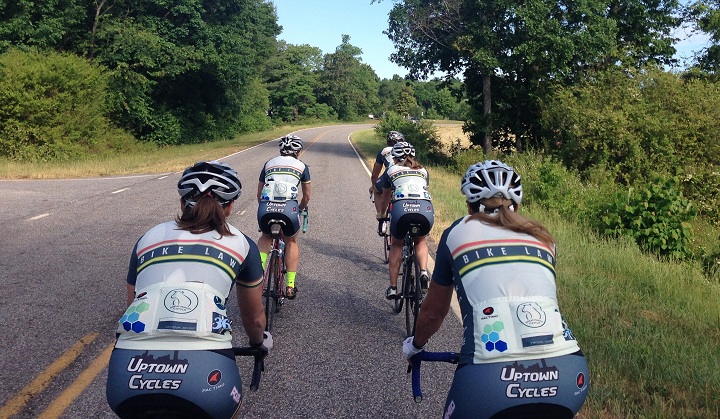Cooperative Principles
Traffic Laws
- Bicyclists follow the normal rules of the road for drivers in order to deter collisions with cars, pedestrians, and other cyclists.
- Bicyclists have the legal right to use public roadways as well as a legal responsibility to negotiate traffic safely and predictably. § 20-4.01(49)
- Bicyclists must obey red lights and stop signs. § 20-158
- When traveling slowly, use the right hand thru lane except when approaching turns. § 20-146(b)
- Ride entirely within a single marked travel lane. Do not ride on a lane line; allow drivers to use the adjacent lane to pass. § 20-146(d)(1)
- Look and yield to adjacent traffic before moving laterally. § 20-146(d)(1)
- Do not pass stopped traffic queues on the right; get in line with other traffic (wait the middle of the lane) at intersections. § 20-150.1
- Respect the traffic laws for operating around school buses and emergency vehicles. § 20-217 § 20-157
- When stopping to rest, talk or regroup, move completely off of the roadway. § 20-161
For additional information on laws, see Important NC Traffic Laws Applicable to Bicyclists
Proximity Considerations
- Riding in close proximity to other cyclists requires additional care.
- The benefits of proximity include greater efficiency (lower wind resistance, less wasted effort), greater speed, and higher traffic throughput.
- Close formations require cooperation and trust. Don’t follow another cyclist at close distance without their consent.
- Physical contact with another rider or their bicycle should never be done without the other rider’s verbal request. This includes contact with a rider to assist in maintaining a consistent speed. Such contact could be unwanted or misconstrued and could also startle a rider and cause loss of control.
Predictability
- Visibility is important. Approach other road users from where they are looking for traffic, and use front and rear lights at night.
- Changes in speed and position should be gradual and not unexpected when in a group.
- The most visible and predictable group formation is a double paceline (see Group Formations).
Communication
- Verbalization – Announce your movements when slowing, stopping, overtaking, and changing formation.
- Signaling – Use hand signals before moving left, right, stopping/slowing, and point out surface hazards and conditions that require moving laterally.
- Call out unexpected or potentially unseen hazards such as potholes, animals, and cars overtaking under unsafe conditions. Don’t call “car back” for every vehicle that overtakes; save warnings for situations that are unsafe or unexpected, such as when other cyclists are encroaching on the left lane, or there is a conflict with oncoming traffic.
- Surface hazards are hard for following bicyclists to see in a group, so take special care to call and/or point them out and lead followers into a safe path around them.
- If you call out, use a direction (ex: “Hole Left” or Hole center”) so following cyclists can avoid the hazard.
- Tell people right away if you experience a mechanical or health problem – this reduces the danger of a collision should you need to slow down or move suddenly, and they can help you with your issue.
- Don’t use headphones, earbuds, or cell phones while cycling. You need to be able to hear other cyclists and to be focused on your surroundings.
